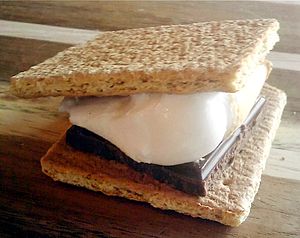Close your eyes and picture it: your favorite comfort food. It’s crusty, maybe, or cheesy, and even a little gooey. Mine is surrounded by a full table near a warm fire on a fall or winter’s night.
Odd, isn’t it then, that I can’t stop thinking about the idea of summer comfort food? But that’s the term swirling around in my mind, for two reasons that I can sum up in one word: s’more.
In some ways, the s’more fits the comfort food profile. At its most pure, it requires a fire. The marshmallow becomes both crusty and gooey. On contact, the milk chocolate melts slightly, and the dry, crisp graham cracker acts as both the perfect transportation device and textural counterpoint.
The snob in me is not ashamed to admit that I love this treat, despite its ordinary construction from maligned convenience foods. In my regular life, I prefer homemade things and dark chocolate, but stick me around a campfire and I’m alright with the packaged and the regular. I’ve played with some alternative ingredients: hazelnut-chocolate spread, caramel, coconut, different kinds of chocolate or graham crackers. I love the experiments, but I don’t need any of that to be fully satisfied. One bite of the basic s’more and I turn into the critic in Ratatouille, who takes a taste of the title dish and finds himself transported back to a time of simple and abiding pleasures.
It’s a funny name, s’more, and the origins of the dish are hard to trace. Most sources point to a Girl Scout cookbook from 1927, and then state the obvious: after you eat one, you want some more. I wouldn’t think too much about it in a different time and place, this fun but greedy contraction. In my current context, in Michigan, in a recession, it rolls around in my mind. While I’ve not given up marshmallows in the name of piety, I can’t help but reflect on those who might need some more of the real basics this summer.
I think of families in the United States who rely on the National School Lunch Program to make ends meet. About 19 million kids receive free or reduced school breakfast and/or lunch. More than thirty-one million kids are served during the course of a year. This helps to offset the needs of the 17 million households living, according to the USDA, with low or very low food security.
A family with low food security reports reduced quality, variety, or desirability of diet due to a lack of resources. They experience little or no indication of reduced food intake, typically due to outside assistance like food stamps, WIC, and school lunch programs. In 2008 (most current data available), 10.3 million households across the U.S. dealt with low food security.
And what of the other 6.7 million households? These families have it worse: they report multiple indications of disrupted eating patterns. This number has increased by 2 million households since 2007, an estimated five-and-a-half million more people going hungry at more than one point during the year. These numbers represent the largest need in the 25-year history of the survey.
What happens to these families when summer comes? I’m imagining new delights to put between two graham crackers. What are they considering, these seventeen million households, an estimated 49 million people living in households dealing with low food security, 16.7 million of them children?
The national numbers are stunning, but are they stunning enough to drive me from slactivism to action? Every year, area food banks report a spike in demand over the summer. What have I done about that? I’m sickened by my own complacency and lack of response. But outrage, even when aimed at myself, doesn’t feed anyone. I must act.
Here are some ways to help:
For further motivation, understand the problem at the state and local level. For example, an estimated 1 in 10 people living in Michigan will need help with food this summer. The percentage of kids in my school district who qualify for free or reduced lunches has risen in the last four years from 16% to 34%: more than 1,000 kids. Numbers in nearby urban areas are much worse. What’s it like for people where you live?
Give money to an area food bank (search for one here). Food banks can buy many goods at lower prices than you will find at a grocery store. This means that if you want to use money to impact the hunger problem, consider giving cash instead of shopping for canned goods. In an op-ed piece published by The Oakland Press, Jane Marshall, the executive director of the Food Bank Council of Michigan, estimates that every dollar donated will help provide five meals. “A $20 donation,” she writes, “can feed a family for two weeks.”
Be a conduit for additional needs. Big food banks serve local pantries, and sometimes these smaller agencies have hard-to-get, high-demand items. For example, my local pantry, OCEF, needs personal care products and, surprisingly, macaroni and cheese. The need is bigger than my ability, but I can host micro-charity events on their behalf. Beyond existing systems, I can reach out to the schools and find a way to help there.
Start or volunteer at a community garden, or donate part of your harvest. Fresh produce is a welcome addition at many food pantries.
Give time. Dedicated volunteers go on vacation, too – summer’s the perfect time to get involved.
Choose to get to know your neighbors well enough to know how to help them personally.
This summer could be the summer of real comfort food.
For the USDA report on food security, visit http://www.ers.usda.gov/briefing/foodsecurity/.

